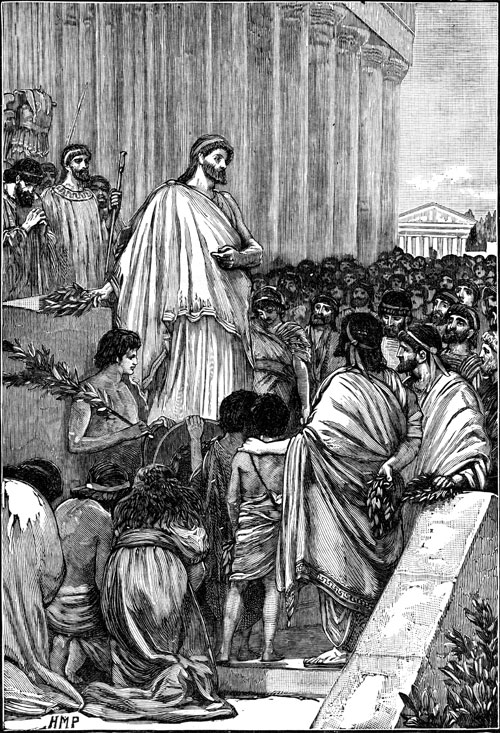Excerpted from the tenth article of William Pierce’s “Who We Are: a Series of Articles on the History of the White Race”:
At the beginning of the fifth century B.C. the Spartiates were able to field an army of 8,000 men against the Persians, but after the costly Spartan victory over Athens and her allies in the Peloponnesian War (431 -404 B.C.) Spartan numbers declined rapidly. When the Spartiates marched against Thebes in 371 B.C., there were too few of them to prevail. After their decisive defeat by the Thebans at Leuctra, the Spartan army numbered only 2,000 warriors. A century and a half later there were only 700 of them, and they passed from the pages of history.
The Spartiates never succumbed to racemixing, but they did succumb to their own lifestyle. They would have been well advised to eliminate the Helots of the Peloponnesus and the Mediterranean population of Crete altogether and to establish a purely Dorian peasant class in those areas. Then they may well have been able to practice a successful eugenics program, maintain their moral health, and have a stable population too. But, of course, they did not have the advantage which hindsight gives us.
The other Hellenic tribes did succumb to racemixing. Their populations did not suffer the decline in numbers which the Spartiates did, but they suffered a decline in racial quality which resulted in their extermination, perhaps more slowly but just as surely—and less cleanly.
Predominantly Nordic
Still, the earliest Athenians were, like the other Hellenes, predominantly Nordic in blood and culture. Their social structure was aristocratic, and they were ruled originally by hereditary kings, just as in the case of the Spartiates.
 Although Athenian tradition credits the legendary King Theseus with the political unification of the various semi-independent townships of Attica into a single “greater Athens” during the Heroic Age, it is certain that this unification actually did not take place until long after the Dorian invasion. In any event, the monarchy did not last long in unified Attica, and at the dawn of history the Athenians were ruled by a coalition of noble families, the Eupatrids (“those who are well sired”).
Although Athenian tradition credits the legendary King Theseus with the political unification of the various semi-independent townships of Attica into a single “greater Athens” during the Heroic Age, it is certain that this unification actually did not take place until long after the Dorian invasion. In any event, the monarchy did not last long in unified Attica, and at the dawn of history the Athenians were ruled by a coalition of noble families, the Eupatrids (“those who are well sired”).
Race-Based Citizenry
Even after Solon, however, democracy did not devour the Athenians all at once. Solon and the tyrants who gained power shortly after his administration, the Peisistratids, governed an Athens in which citizenship was still a racial matter, being based on membership in one of the kinship groups, or clans, which made up the Hellenic tribes of Attica.
In 509 B.C., 85 years after the beginning of Solon’s administration, another “reformer,” Cleisthenes, took office, and he undertook a program of gerrymandering which laid the basis for changing citizenship from a racial to a geographic affair. From this point it was downhill all the way for Athens, racially speaking.
Half a century later the last remnants of power were transferred from the Areopagus to a popular council. All the abuses of mass party politics with which Americans are all too familiar were thenceforth the lot of the Athenians.
Law of Pericles
As the prosperity of Athens grew, more and more foreigners crowded into Attica, with intermarriage inevitably occurring. A temporary halt to the pollution of the Athenian citizenry by the offspring of aliens came in 451 B.C., when the great Pericles pushed through a law restricting citizenship to those born of an Athenian father and an Athenian mother. Only four decades later, however, in order to make up the enormous losses suffered in the Peloponnesian War, Athens bestowed citizenship on tens of thousands of foreigners.
 And in the fourth century, although the citizenship law of Pericles remained on the books, every variety of Levantine mongrel was claiming Athenian citizenship. The banking industry of Athens, for example, was entirely in the hands of Semites, who had taken Greek names and were awarded citizenship for “service to the state,” much in the way Jews and Negroes have been elevated to the British “nobility” by the score in recent decades.
And in the fourth century, although the citizenship law of Pericles remained on the books, every variety of Levantine mongrel was claiming Athenian citizenship. The banking industry of Athens, for example, was entirely in the hands of Semites, who had taken Greek names and were awarded citizenship for “service to the state,” much in the way Jews and Negroes have been elevated to the British “nobility” by the score in recent decades.
Darkening of Hellas
Intermarriage was rife, and the darkening of the Hellenes of Athens was well under way. Racial, moral, and cultural decline went hand in hand. The second-century historian Polybius described his countrymen as “degenerate, pleasure-seeking beggars, without loyalty or belief, and without hope for a better future.”
A century later, in the reign of Augustus, the Roman writer Manilius reckoned the Hellenes among the dark nations (coloratae genies). And so the Athenians, like the Spartiates, passed from the pages of history.
If it is difficult to believe that as great a state as Athens could pass from Nordic genius and glory to mongrelized squalor in a few centuries, just think for a moment of the racial transformation of America which has taken place in a single century. And imagine what America will be like two or three centuries hence (barring a White revolution), when Whites are a minority, outnumbered by both Blacks and Chicanos. America’s technology and industry may coast along for a century or two on the momentum acquired from earlier generations, as Athens’ culture did, but the American people—the real Americans—will have passed from the pages of history.

3 replies on “White suicide since Ancient Greece”
I’d like to leave a few comments on how utterly wrong this entire article is. Firstly, although the Ancient Spartans and Ancient Greeks in general were most likely whiter and more Aryan than modern-day Greeks, they were all in actuality less white than the ancient Persians, as so described by various Greek sources, not Persian, including famous writers Herodotus and Xenophon:
“Xenophon describes the Ethiopians as black and the Persian troops as white compared to the sun-tanned skin of Greek troops.[5] Herodotus similarly used Melanchroes “dark-skinned” for the Egyptians and he compared them to the Aithiopsi “burned-faced” for the Ethiopians. Herodotus also describes the Scythian Budini as having deep blue eyes and bright red hair.[6]”
(from Wikipedia. Not the best source in the world, but it has links to other sources, and I noticed that you provided no source citations in this article whatsoever.)
Also, by so boldly claiming that the Spartans were “Nordic in blood and culture,” you neglect to mention that “Nordic culture” didn’t so much as exist until at least the 7th century AD, with the advancements and conquests made by the Vikings and the Anglo-Saxons. Before them were such “aristocratic” “social structures” as ancient Egypt, ancient Babylon, the Persian Empire (the first true empire the world had ever seen), and the Roman Empire, (constantly referred to as the greatest empire in the history of Western civilization) none of whom were Nordic. In fact, it was the savage Nordic/Germanic tribes of the north who ultimately brought an end to Rome.
“Persian troops as white compared to the sun-tanned skin of Greek troops” means that the Aryan Helens were sun-tanned after a long military campaign, not genetically swarthy.
Pierce used the term Nordic very loosely in this sentence after he became tired of using the more precise “Indo-European”. What he meant is obvious. In contrast with the Mediterranean whites of the age, Indo-Europeans were “Nordics” in the sense of whiter and blonder, etc.
Similarly, IIRC he also made it clear that there were no “Germans” properly in those times when referring to Germanic peoples. But after using the name of the specific Germanic tribes, if you are writing for a non-academic audience sooner or later you will also find yourself using the term “Germans” to speak of the peoples that Tacitus wrote about.
Reblogged this on giavellireportadmin and commented: